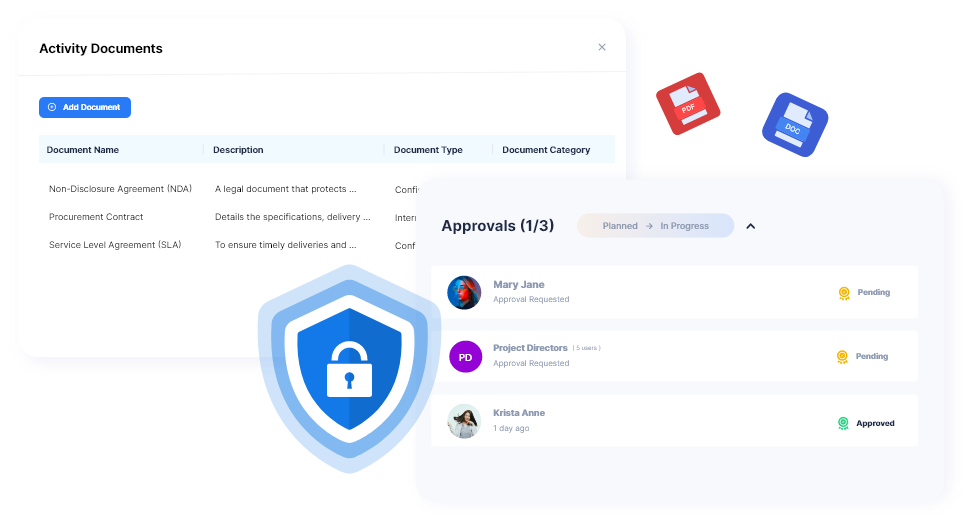 Procurement teams operate in a space where one missed step can trigger costly fines, strained supplier relationships, or damage to an organization’s reputation. The pressure to reduce compliance risks in procurement has never been higher, with regulations evolving faster than many manual processes can keep up. Better workflows in procurement offer more than efficiency, they create built-in safeguards that standardize processes, enforce policy compliance, and keep every transaction audit-ready.
Procurement teams operate in a space where one missed step can trigger costly fines, strained supplier relationships, or damage to an organization’s reputation. The pressure to reduce compliance risks in procurement has never been higher, with regulations evolving faster than many manual processes can keep up. Better workflows in procurement offer more than efficiency, they create built-in safeguards that standardize processes, enforce policy compliance, and keep every transaction audit-ready.
The Compliance Challenge in Procurement
Procurement sits at the intersection of financial stewardship, supplier relationships, and regulatory accountability. When this function falls out of compliance, the ripple effects can undermine not just budgets, but the integrity of an entire organization.
Definition & Scope
Compliance risks in procurement arise when purchasing actions deviate from internal mandates, legal regulations, or ethical standards. This includes unauthorized spending, supplier misconduct, bribery, data vulnerabilities, and incomplete audit documentation. Managing these risks strategically transforms compliance from constraint to advantage. Deloitte underscores the growing imperative of integrating risk management throughout procurement, not just at points of regulation, but as a continuous enabler of resilience and agility.
The Real Cost
The stakes of non-compliance are steep:
- Financial Losses – Penalties, overpayments, and contract disputes directly erode margins.
- Operational Disruption – Delays, supply chain breakdowns, and abandoned commitments.
- Reputational Damage – Regulatory breaches and supplier failures can reverberate through reputation and erode stakeholder confidence.
For instance, PwC’s Global Economic Crime Survey 2024 names procurement fraud among the top three most disruptive economic crimes globally—ranking just after cybercrime and corruption. This underscores that compliance failures aren’t hypothetical—they’re urgent and costly.
 Why Now
Why Now
Two forces are converging to raise the compliance stakes:
1. Regulatory Complexity
Global procurement extends across diverse jurisdictions, each with evolving legal and ESG obligations. Deloitte’s third-party risk management survey shows that firms facing geopolitical pressures and sustainability mandates must modernize their risk approach to remain compliant and resilient.
2. Operational Complexity
Traditional, manual procurement workflows are buckling under modern demands. Gartner reveals that organizations clinging to outdated sourcing processes are 26% more likely to complicate transformation efforts and significantly lag their peers in success.
The message is clear: manual routines and scattered spreadsheets aren’t just inefficient—they expose organizations to unnecessary risk.
How Better Workflows Transform Compliance
Compliance in procurement is not achieved by chance. It requires an environment where policies are applied consistently, approvals are enforced without bias, and every decision leaves a traceable footprint. Better workflows make this possible by turning fragmented, manual processes into structured, automated systems that protect your organization from risk while improving operational efficiency.
From Chaos to Clarity
When procurement processes are inconsistent, compliance risks multiply. Different teams may interpret policies in their own way, skip critical steps, or bypass approvals altogether. Standardized workflows eliminate these gaps by clearly defining every stage of procurement from requisition to payment. With uniform steps and documented procedures, every purchase follows the same path. This consistency removes ambiguity, minimizes room for error, and ensures that regulatory and internal compliance requirements are met every time.
Automation as Guardrails
Manual approvals often leave room for delays, oversights, or policy breaches. Automated workflows act as compliance guardrails by routing requests through predefined approval hierarchies based on role, department, or spend thresholds. Policies such as mandatory approvals, vendor prequalification, and spending limits are built directly into the workflow logic. As a result, the process enforces compliance automatically rather than relying on individuals to remember or interpret the rules.
Audit-Ready by Default
In procurement, an incomplete paper trail can be as damaging as a policy breach. Digitalized workflows capture every action in real time including requests, approvals, changes, and communications. This creates a complete, time-stamped record of procurement activities. When an audit occurs, teams can instantly retrieve documentation that verifies compliance with regulations and internal policies. Transparency is no longer a reactive effort; it becomes a natural outcome of the way the workflow is built and executed.
The Core Compliance Benefits of Improved Workflows
Better workflows are more than a productivity boost. In procurement, they become a built-in compliance safeguard, ensuring every action aligns with policy, regulation, and operational best practice. Here’s how an optimized workflow framework delivers measurable risk reduction.
 Standardization of Processes
Standardization of Processes
When procurement follows a clearly defined sequence from requisition to payment, there is no room for interpretation or guesswork. Standardization ensures every request passes through the same checkpoints, with documented procedures guiding each step. This not only eliminates shortcuts and inconsistent application of policies but also creates a predictable, audit-ready trail that can be reviewed at any time.
Automated Approvals & Compliance Controls
Rules-based approval routing ensures that only authorized individuals can approve spend within their assigned thresholds. Automated workflows apply compliance checks at each stage, verifying budget availability, vendor status, and policy alignment before a purchase proceeds. This automation reduces the likelihood of fraudulent transactions and prevents unauthorized spending from slipping through the cracks.
Real-Time Visibility & Audit Trails
With a fully digitalized workflow, every decision, approval, and change is captured in real time. Procurement teams can instantly access historical data, making it simple to trace back decisions during audits or investigations. This level of transparency allows anomalies to be spotted and addressed quickly, preventing small issues from becoming costly compliance failures.
Supplier Vetting & Continuous Monitoring
Compliance risk often originates with the suppliers themselves. Integrated workflows can link directly to vendor management systems, automatically checking qualifications, certifications, and compliance status before a supplier is approved. Ongoing monitoring ensures that vendors remain compliant over time, reducing exposure to unreliable or high-risk partners.
Regulatory Agility
Procurement regulations change frequently. Workflows that can adapt quickly help organizations stay compliant without operational disruption. By embedding regulatory checklists and updating approval logic dynamically, teams can respond to new legal requirements or policy shifts in real time, avoiding last-minute contract renegotiations or penalties.
Data-Driven Decision Making
Modern workflow platforms integrate analytics that track spend patterns, supplier performance metrics, and compliance KPIs. Procurement teams can use this data to identify high-risk categories, refine supplier selection, and allocate resources strategically. Data-backed decisions mean less reliance on assumptions and a stronger ability to balance cost efficiency with compliance priorities.
Error Reduction & Cost Savings
Manual data entry and paper-based approvals are prone to mistakes that can trigger compliance issues. Automation removes these risks by validating information and matching documents automatically. As a result, procurement cycles move faster, costs drop, and compliance is strengthened through process accuracy and efficiency.
Why a Workflow Management Platform is the Missing Link
In modern procurement, reducing compliance risks is not simply about enforcing rules. It is about embedding compliance into the DNA of every process so that following the right path becomes effortless. A Workflow Management Platform like Planally does exactly that by transforming procurement from a patchwork of manual steps into a seamless, compliance-first ecosystem.
 Built-In Compliance Logic
Built-In Compliance Logic
Planally ensures compliance is never an afterthought. Role-based approvals route every purchase request through the correct decision-makers based on spend thresholds, department, or strategic priority. Embedded policy rules prevent unauthorized actions before they happen, so every procurement step is aligned with internal guidelines and external regulations from the start.
Policy-Embedded Workflows
Every Planally workflow can be designed with compliance checkpoints built in. Mandatory documentation fields, approval prerequisites, and spend limits are not just reminders but enforced steps within the process. This ensures that no procurement request can bypass the standards that protect the organization from risk.
Audit-Ready by Design
With Planally, procurement records are not scattered across spreadsheets or email chains. Every action, approval, and document is stored in a centralized, searchable system. This creates a complete, chronological audit trail that makes compliance verification straightforward, accelerates audit preparation, and builds confidence with regulators and stakeholders alike.
Scalable and Customizable
Regulatory requirements and business priorities evolve constantly. Planally adapts to these changes without the need for complex overhauls. Teams can easily configure workflows to reflect new policies, approval criteria, or reporting needs, ensuring compliance processes remain relevant and effective no matter how the procurement landscape shifts.
By embedding compliance into every workflow, Planally eliminates the friction and uncertainty that often plague procurement teams. The result is a procurement function that operates with clarity, speed, and complete confidence in its compliance posture.
Conclusion — Compliance Without the Chaos
Better workflows are not just an efficiency upgrade, they are a safeguard for procurement integrity. By standardizing processes, automating approvals, embedding policy controls, and ensuring real-time visibility, organizations can detect and prevent compliance breaches before they escalate. Procurement teams gain the confidence that every purchase aligns with regulations, while also unlocking faster cycle times and reduced operational costs. This dual advantage means compliance becomes a natural part of the process rather than an afterthought, allowing teams to focus on strategic value creation instead of firefighting risks.
Move from Risk to Readiness
One Platform. Every Procurement Workflow. Full Compliance.
Planally gives you the structure, visibility, and automation to make every procurement decision airtight. Reduce risk, cut cycle times, and keep your processes audit-ready from day one.
Explore Planally for Procurement →




